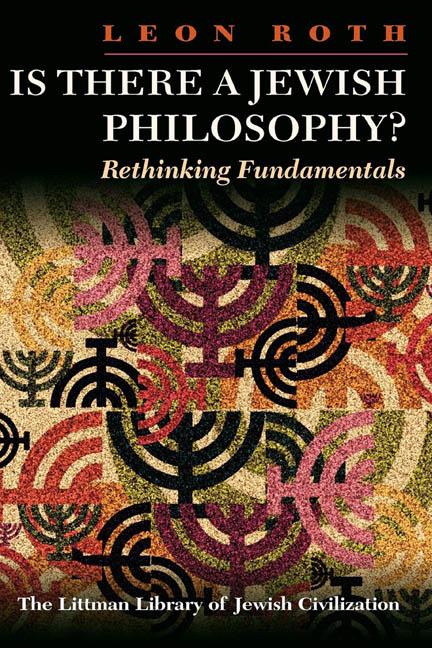Book contents
- Frontmatter
- Dedication
- Contents
- Publisher's Note
- Foreword
- Note
- Is there a Jewish Philosophy?
- Imitatio Dei and the Idea of Holiness
- Jewish Thought as a Factor in Civilization
- The Significance of Biblical Prophecy for Our Time
- Some Reflections on the Interpretation of Scripture
- Baruch Spinoza: His Religious Importance for the Jew of Today
- Judaism: The Elements
- Authority, Religion, and Law
- Moralization and Demoralization in Jewish Ethics
- Mysticism, Thick and Thin
- Back To, Forward From, Ahad Ha'am?
- Maimonides
- Bibliography of the Writings of Leon Roth
- Index
Back To, Forward From, Ahad Ha'am?
- Frontmatter
- Dedication
- Contents
- Publisher's Note
- Foreword
- Note
- Is there a Jewish Philosophy?
- Imitatio Dei and the Idea of Holiness
- Jewish Thought as a Factor in Civilization
- The Significance of Biblical Prophecy for Our Time
- Some Reflections on the Interpretation of Scripture
- Baruch Spinoza: His Religious Importance for the Jew of Today
- Judaism: The Elements
- Authority, Religion, and Law
- Moralization and Demoralization in Jewish Ethics
- Mysticism, Thick and Thin
- Back To, Forward From, Ahad Ha'am?
- Maimonides
- Bibliography of the Writings of Leon Roth
- Index
Summary
IN the early years of the century there appeared a remarkable book, by the Italian Croce, entitled: What is Living and What is Dead in the Philosophy of He gel? The subject on which I wish you to direct your attention today is: What is living, and what is dead, in Ahad Ha'am?
By ‘living', I mean what is living for us, by ’dead', what is dead for us. In the recently published volume Tradition and Change on the development of the Conservative movement in the Jewry of the United States, there is excerpted an address by the present Vice-Chancellor of the Jewish Theological Seminary of America in which the first of the ‘four tested standards’ of the movement is declared to be ’scientific knowledge of the whole of Judaism'. The aim is ambitious and I hope the Seminary lives up to it. But even after the ‘whole of’ Judaism has become known scientifically, there still remains the task of its evaluation. Evaluation is not the business of science. Science describes; it does not judge. But life means judgement, discrimination, selection. On doit choisir. There are subjects and opinions which for us today are more significant than others and it is these which we have to look out for. What then can we find today of significance in Ahad Ha'am, and, having found it, how and where do we go on further?
It should be said at once that we are all of us, in some sense and in some degree, disciples of Ahad Ha'am. We all use his ideas, all speak his language. They are current coin, passed from hand to hand, without thought of the mint in which they were struck. And if we turn again to his writings, we can see the secret of his appeal. Here is a man, we say to ourselves, who talks sense; and he talks sense sensibly. He knows where to begin, and when to stop. His prose is prose, not pastiche. He displays a breadth of vision, a width of interest, a substratum of seminal ideas, which we miss in some other modern Hebrew writers. He is worthy of all admiration; but-and here is my first point-let us admire him for what he is, not for what he is not.
- Type
- Chapter
- Information
- Is There a Jewish Philosophy?Rethinking Fundamentals, pp. 156 - 168Publisher: Liverpool University PressPrint publication year: 1999



